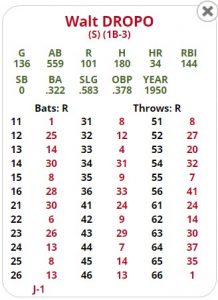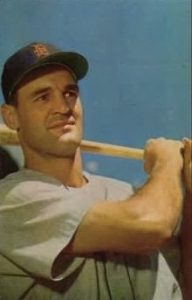
I have to admit, I didn’t know much about Walt Dropo before I started researching players for First Card Friday. I vaguely remember his name, and I certainly couldn’t have told you that he was the AL Rookie of the Year in 1950. But, that’s the beauty of APBA; it takes you in so many unexpected and interesting directions. When you see Walt Dropo’s 1950 APBA card, you lose your breath for a moment. Immediately, you ask yourself, “who the heck was this rookie?”
Walt Dropo was a three-sport star athlete from Moosup, Connecticut. Because of the name of his hometown and his size (6-5, 220), Dropo got the nickname “Moose.” Dropo played football, basketball, and baseball at Plainfield High School before attending the University of Connecticut, where he continued his athletic prowess. Walt’s best sport was probably basketball. When he left UCONN, he was the school’s all-time leading scorer. This made him a first-round pick in the BAA (Basketball Association of America), the precursor to the NBA. In that same year, 1946, Dropo was also drafted in the 9th round by the NFL’s Chicago Bears. Yet, being drafted is one thing, signing a contract worth money is another. So, when the Boston Red Sox offer Walt a free agent contract in 1947, Dropo went with the money.

After a couple of years in the minors, plus a brief eleven-game cup of coffee with the Red Sox in 1949, Walt Dropo burst onto the scene in 1950. Dropo started the year in the minors but was called up after Billy Goodman was injured. Immediately, Dropo started producing in his Rookie of the Year campaign. On May 3rd, he hit his first Major League home run off Bob Feller. It was at that point Walt knew he belonged in the Big Leagues. For the rest of the season, he was on a terror, hitting .322 with the second-most homers (34) in the league. Dropo tied for the American League lead in runs batted in (144) and led in total bases (326). Among the many impressive feats of his 1950 season, the fact that a rookie had more RBI (144) than games played (136), stands out.
Upon closer inspection, is easy to understand how this card produced an All-Star and a 6th place finish in the AL MVP voting. I project it to hit for a .327 average, due to the extra 8 APBA gave it. Even though Dropo was rated (S), he did receive a 33-4 because he hit a career-high eight triples in 1950. Most importantly, this card has two first column 1s, plus a 22-6. For a first card, it’s tremendous. In some ways, it reminds me of many of Ted Williams cards…minus several 14s, of course.
Walter Dropo never reached the heights of his 1950 season again, however, he did have several other productive years in his 13-year career. It’s likely he was slowed because of a fractured arm in 1951, which led to the Red Sox trading him to the Detroit Tigers. However, his second claim to fame came with my favorite team, the Detroit Tigers. In July 1952, Dropo tied a Major League record by recording 12-straight hits and 16-hits in three games. 1952 was Dropo’s second-best season when he hit .276 with 29 home runs and 97 RBI. Walt finished 26th in the MVP voting.
Dropo’s production declined after 1952 and he bounced around with several teams, including the Cincinnati Reds and Baltimore Orioles. His last productive season was in 1955 for the Chicago White Sox when he hit .280 with 19 homers and 79 RBI. After just 14 games with the Orioles in 1961, Dropo decided to call it a career.
Not every Rookie of the Year becomes a Hall of Fame player. I’m sure Red Sox fans were hoping, in 1950, that Dropo would become a perennial All-Star. It was not to be. Yet, Walter Dropo was a productive Big League player. At the end of his life, he was satisfied with his career. Let’s think about it. Most boys would be happy to grow up to play in the Majors for 13-years and say they hit .270 with 150+ homers and 1,000+ hits and won a Rookie of the Year Award. Walt Dropo is one of the few who could say it.



